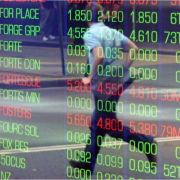Riding out the deflation storm
| Summary: The debt overhang from the global financial crisis lingers, and world growth is likely to remain lacklustre for some time. Furthermore, a secular bear market is unlikely to end before global debt deleveraging is completed. |
| Key take-out: Secular bear markets consist of a series of primary bull and bear waves. The best way to cope with these is to trend-trade them so you ride the rises, but sidestep the falls. One way of doing this is via an exchange-traded index fund. |
| Key beneficiaries: General investors. Category: Shares. |
The biggest brake on households and government spending in America and Europe (and also Australia) is a large debt overhang from the global financial crisis. After the mid-1990s households went on a spending spree funded by mortgages and credit cards. When the music stopped in 2007 home prices fell (except in Australia) leaving many households with negative equity and banks on the verge of collapse. As tax revenues fell, unemployment relief rose and banks got bailed out by the state, public debt escalated to record heights.
Larry Summers, the former chair of President Obama’s Council of Economic Advisers, endorses recent academic research which finds that excessive debt was the cause of the GFC and that a near banking collapse was a symptom of this, not the cause of the crisis. See Professors’ Atif Mian and Amir Sufi: House of Debt: How They (and You) Caused the Great Recession and How We Can Prevent it from Happening Again.
However Summers parts with them on their prescription, which is to forgive household debt rather than bail out banks too big to fail.
I share the view that a secular bear market is unlikely to end before global debt deleveraging is completed. So I agree that deflation, which is a consequence of increased savings to pay off debt, remains a drag on recovery. Though, notice from the above charts that the US has made better progress on household deleveraging than Canada and Australia.
If central banks succeed in persuading households to borrow more, that would fuel a sugar hit followed by a consumer slump as rising interest rates made debt less affordable. There is no easy way out of this trap, which is why world growth is likely to remain lacklustre as long as households continue to treat saving as the new spending.
Secular bear markets consist of a series of primary bull and bear waves. The best way to cope with these is to trend-trade them so you ride the rises, but sidestep the falls.
The chart below shows secular bull and bear markets in the US since 1990. They are depicted by different colours – blue for bull and red for bear. The S&P 500 index is expressed in constant prices (i.e. discounted for inflation).
Notice that within (red) secular bear markets there are still primary bull markets like the one since March 2009.
I don’t have a comparable chart for Australia, but as can be seen below Australia’s sharemarket movements have been heavily influenced by America’s. When America sneezes, we catch a cold. The black line in the chart is the Australian All Ordinaries share index, while the blue one is America’s S&P 500 share index.
Most fundamental analysts say the US and Australian sharemarkets are not overvalued since their trailing price/ earnings ratios are both close to 15, which is the historical norm. But Doug Short, the head of stock market research firm DNShort.com (a great site for historic charts) says that on technical analysis the US stock market is sitting well above its long term trend line and so is vulnerable to collapse. That’s because past secular bear markets did not end until the inflation adjusted share index got close to the floor of the upward slanting channel.
Only record profit margins, especially by financial corporations, are making the market’s price /earnings ratio look reasonable. But if world growth remains subdued earnings will wilt, exposing markets as grossly overvalued. That could precipitate a crash.
That’s why a proven trend-trading system is necessary for keeping you on the right side of the market. Should it crash, I shall pull out early. But if it keeps going up, I shall hang in for the ride.
The secret to good trading is navigating the big waves for the All Ords index by investing in an exchange-traded fund like the SPDR/ASX 200 Fund (ASX code STW), which trades like an ordinary share but covers the top 200 Australian listed companies.
That’s why I am a slow, not frequent, trader because trying to exploit small waves loses money as most aggressive traders do. For me, big-trend trading is good risk management, not adrenalin driven speculation. It’s about staying out of crashes because history shows that is the safest way of accumulating wealth in the share market.
Note below that the VIX index has hit a low not seen since before the GFC. The bulls say this means investor confidence has been restored and so it’s full steam ahead. The bears say this shows investors have become complacent, just as they did in late 2007 before the market turned sour.
My advice is don’t be guided by this fear index, but watch the market’s medium and long-term trends and momentum for guidance on what to do. Whether current conditions reflect the calm before a storm or a genuine return to normality, only time will tell. But, in the meantime, I will use trend-trading signals to tell me when the market is healthy and when it’s sick.
Percy Allan is a director of MarketTiming.com.au. For a free three week trial of its newsletter and trend-trading strategies for listed ETF funds, see www.markettiming.com.au.























